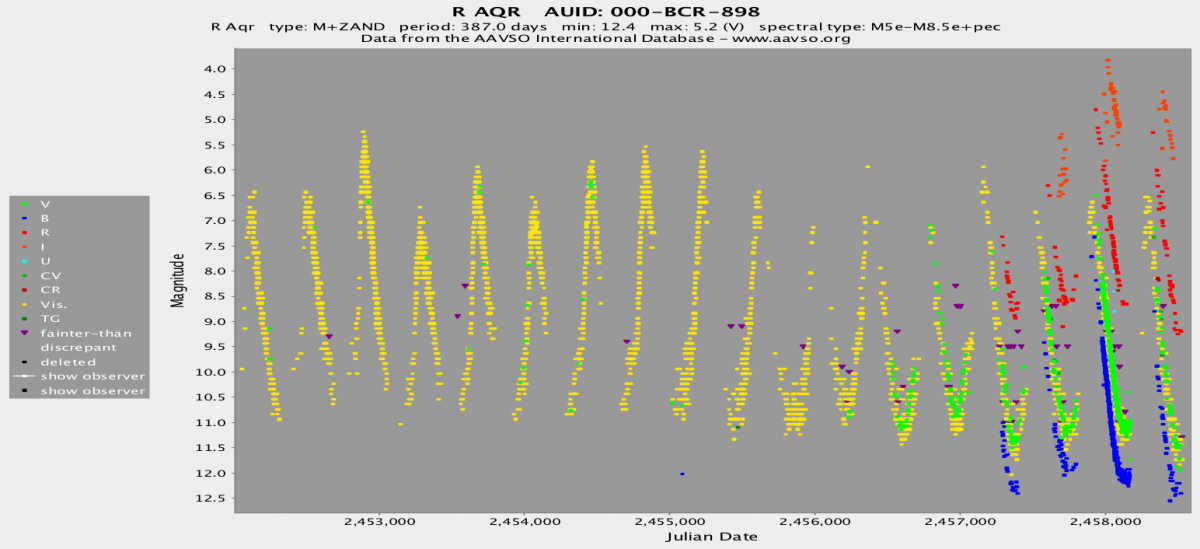Note: Dr. Margarita Karovska (Center for Astrophysics|Harvard & Smithsonian) is also urgently requesting BVRI photometry, visual observations, and spectroscopy of R Aqr through (at least) the end of the observing season. - Elizabeth O. Waagen, August 5, 2019
Note: R Aqr is out of its seasonal gap and is increasingly observable. Continued coverage is requested as described below until further notice. - Elizabeth O. Waagen, May 3, 2019
April 19, 2019: Dr. Lee Anne Willson (Iowa State University) is urgently requesting observations of the symbiotic Mira R Aqr, particularly from our Southern observers.
Dr. Willson writes: "The current minimum is low [V~11.7], and possibly even [low] in R and I, so we may be seeing the start of the eclipse/interaction event that [occurs every 44 years and] should be centered around 2022 to 2024 and lasts about 6 years. Thus more observations near minimum would be particularly useful at this time!
"For our project, visual and V, R, I, and B are all useful, as would be farther into the IR if anyone has access to the right equipment. The importance of R and I and farther into the IR is that last time these all came down together, a strong hint that the Mira is being blocked by something fairly opaque that does not cover the whole star. Depending on how...the data [are folded] there is some hint that the current cycle is also showing depressed R and I. So there is reason to think the event may be underway, but the case is not yet compelling."
Nightly BVRI CCD and DSLR photometry and visual observations are requested. R Aqr is too close to the Sun to observe from the Northern hemisphere at present, but observers in the Southern hemisphere have a better chance. Please observe R Aqr for as long as possible, and pick it up again as soon as it becomes observable.
Spectroscopy focusing on seeing the emission lines is also requested. "Lower resolution will be interesting if there are unusual emission lines - beyond the normal emission lines that Miras show."
Another campaign was started on R Aqr in 2016 at the request of Dr. George Wallerstein (University of Washington) and is still running; please see AAVSO Alert Notice 535, which also contains more information about R Aqr and a link to the AAVSO's Variable Star of the Season (VSOTS) webpage on R Aqr. The long term light curve in the VSOTS article is overlapped and updated below.

AAVSO light curve of R Aqr March 2001-February 2019 (JD 2452000-2458527). 250 observers worldwide contributed 5,336 observations to this light curve from the AAVSO International Database.
Coordinates (J2000): R.A. 23 43 49.46 Dec. -15 17 04.2
Charts with a comparison star sequence for R Aqr may be created using the AAVSO Variable Star Plotter (VSP).
Please report all observations to the AAVSO International Database using the name R AQR.
AAVSO Forums: This campaign is the topic of the AAVSO Campaigns and Observation Reports forum thread https://www.aavso.org/r-aqr-campaign-2019 and the Long Period Variables forum thread https://www.aavso.org/r-aqr-campaign-2019-01
This AAVSO Alert Notice was compiled by Elizabeth O. Waagen.
----------------------------------
SUBMIT OBSERVATIONS TO THE AAVSO
Information on submitting observations to the AAVSO may be found at:
https://www.aavso.org/webobs
ALERT NOTICE ARCHIVE AND SUBSCRIPTION INFORMATION
An Alert Notice archive is available at the following URL:
https://www.aavso.org/aavso-alert-notices-for-observing-campaigns-and-di...
Subscribing and Unsubscribing may be done at the following URL:
https://www.aavso.org/aavso-alert-notice-subscribe
-------------------------------------------------
Please support the AAVSO and its mission -- Join or donate today:
https://www.aavso.org/apps/donate/

